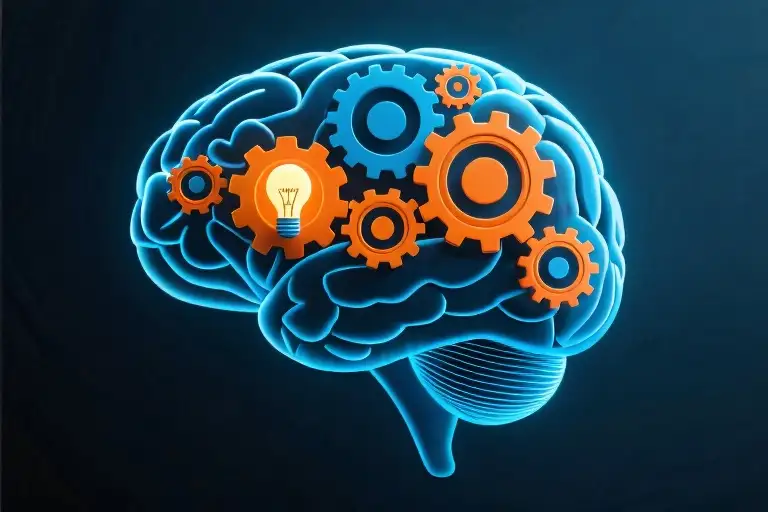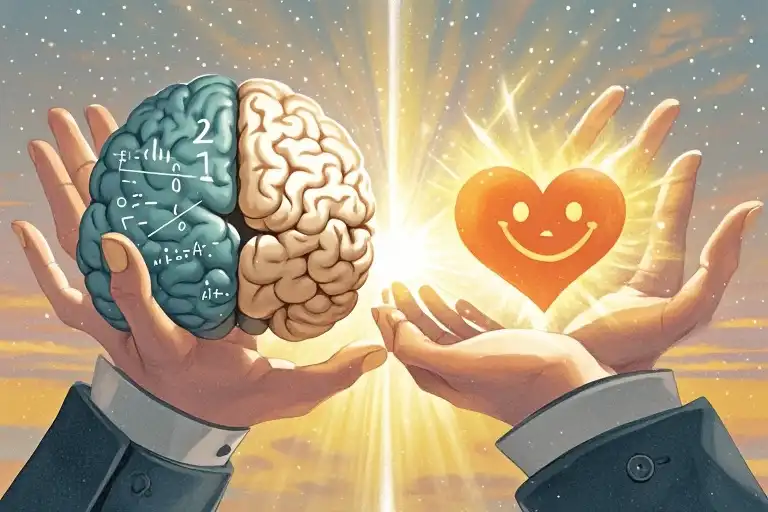The clock blinks 2:17 AM as your bleary eyes scan another product page. Your prefrontal cortex checked out hours ago, but the bright red banner pulses insistently: “Only 1 left!” Before conscious thought catches up, your finger stabs the “Buy Now” button. Three days later, the unopened package mocks you from the corner. We’ve all been there—that moment when our autopilot overrides rational judgment.
This isn’t just about willpower. It’s about how our brains evolved to make snap decisions in survival situations, leaving us vulnerable in a world where “limited stock” notifications have replaced saber-toothed tigers. The same mental shortcuts that helped our ancestors avoid danger now make us click “Agree” on terms we never read and purchase items we don’t need.
Consider the 1966 TV showdown between Frank Zappa and host Joe Pyne. When Pyne sneered that Zappa’s long hair made him “a girl,” the musician retorted, “I guess your wooden leg makes you a table.” Beyond the brilliant clapback, this exchange reveals our tendency to judge complex things by single features—a cognitive trap marketers exploit daily. That “Only 1 left!” alert? It taps into the same reductionist thinking that made Pyne equate hairstyle with gender.
Modern influence tactics have simply weaponized what psychologists call automatic decision-making. When cognitive resources dwindle—whether from exhaustion, information overload, or stress—we default to these mental shortcuts. Sometimes they serve us (like instinctively braking when a car swerves). Other times, they leave us with closetfuls of regrettable purchases and subscriptions we can’t remember signing up for.
The irony? Our brains congratulate themselves for being efficient while getting played. That sinking feeling when the dopamine fades and buyer’s remorse sets in? That’s your slower, logical thinking finally getting a word in edgewise. By understanding how these cognitive traps work—from scarcity bias to authority triggers—we can create friction where it matters most. Not to eliminate quick decisions entirely (that’s impossible), but to ensure our autopilot isn’t flying us straight into a manipulator’s landing strip.
The Autopilot Paradox: When Efficiency Becomes Vulnerability
That moment when your finger taps ‘Buy Now’ before your brain even registers the price—we’ve all been there. It’s not just about willpower. Our brains are wired to take shortcuts, especially when we’re mentally exhausted. The MIT “Exhausted Shopper” study found something startling: decision fatigue can increase impulse purchases by up to 40%. When cognitive resources run low, we default to automatic responses that evolved to save energy, not necessarily to make optimal choices.
This mental autopilot serves us well in many situations. You don’t consciously think about every muscle movement when walking, just as you don’t deliberately analyze every social interaction. But in our modern landscape of targeted ads and engineered urgency, these same mechanisms become vulnerabilities. The scarcity bias that once helped our ancestors grab limited resources now makes us vulnerable to “Only 1 left!” notifications. The social proof instinct that guided tribal behavior now translates into blindly following five-star reviews.
What’s fascinating—and slightly unsettling—is how predictable these patterns are. Cognitive scientists identify this as the “cognitive miser” phenomenon: our brains default to the least demanding processing mode. It’s not laziness; it’s efficiency. But like any shortcut, it comes with trade-offs. Quick judgments based on single features (like equating long hair with femininity in Frank Zappa’s case) often miss complexity. The same mental pattern that helps us navigate crowded sidewalks also makes us susceptible to marketing that triggers our automatic “yes” response.
Three key insights emerge from the research:
- Depletion dictates compliance: Willpower is finite. The more decisions you make, the more likely you’ll operate on autopilot.
- Bias loves brevity: Single-feature judgments (appearance, titles, urgency cues) override nuanced thinking when we’re tired.
- Context is everything: What serves us in one environment (like quickly identifying threats) works against us in others (like evaluating limited-time offers).
The irony? We’re most vulnerable to these influence techniques when we most need protection—after long work hours, during stress, or when multitasking. Recognizing this paradox is the first step toward more intentional decisions. Not by eliminating automatic thinking (an impossible task), but by creating simple safeguards for when our cognitive guard is down.
The Influencer’s Toolkit: Why We Say Yes Without Thinking
That moment when your finger hovers over the ‘Buy Now’ button despite better judgment isn’t just weak willpower—it’s your brain running an ancient shortcut. Robert Cialdini’s research reveals how certain triggers bypass our rational thinking, and marketers have turned this into a science. Three principles in particular—scarcity, authority, and social proof—act like psychological hotkeys that prompt automatic compliance.
The Scarcity Illusion
Limited-time offers and ‘only 1 left’ notifications don’t just convey information; they trigger a primal fear of missing out. A University of Minnesota study found that simply adding ‘while supplies last’ to a product description increased perceived value by 25%. Our brains interpret scarcity as quality—an evolutionary holdover from when rare resources meant survival advantage. Modern retailers exploit this by:
- Artificial stock counters (ever notice how items stay at ‘last 2’ for hours?)
- Time-limited discounts that disappear at midnight
- ‘Exclusive’ offers that reappear under different names
The Authority Mirage
We’re hardwired to defer to perceived experts—a trait that once helped avoid poisonous plants now makes us trust white-coated toothpaste ads. Cialdini’s hospital experiment showed nurses following clearly incorrect doctor’s orders 95% of the time. Today’s digital world amplifies this through:
- Verified badges on social media
- ‘As seen on’ media logos
- Algorithmically boosted ‘expert’ opinions (notice how financial influencers all suddenly agree?)
The twist? Actual competence matters less than the trappings of authority. A Stanford study found audiences rated identical financial advice 30% more credible when delivered in a custom suit versus casual wear.
Social Proof’s Echo Chamber
That little notification saying ‘128 people bought this today’ isn’t just informative—it’s persuasive. When uncertain, we assume the crowd knows best. New York University researchers found restaurants displaying ‘most popular’ tags saw 13-20% more orders for those items, even when randomly assigned. Digital platforms intensify this through:
- Purchase counters that update in real-time
- Testimonials with headshots (bonus points for diverse demographics)
- Follower counts displayed like credibility scores
Here’s the uncomfortable truth: These triggers work even when we’re aware of them. In a Harvard experiment, participants who’d just studied persuasion techniques still fell for scarcity tactics 23% more often than control groups.
Your Mental Firewall
Building resistance starts with recognizing these patterns in real time:
- Scarcity reality checks: Ask ‘Was this truly made scarce, or made to appear scarce?’ (Pro tip: Check camelcamelcamel.com for Amazon price histories)
- Authority audits: Separate credentials from presentation—would this advice hold weight without the title/labels?
- Social proof skepticism: Remember that crowds can be wrong (see: every financial bubble ever). Look for independent reviews beyond platform-curated testimonials
The most effective defense? Introducing friction. A simple 10-second pause before clicking ‘purchase’ reduces impulse buys by 40%, according to Journal of Consumer Research data. Your future self will thank you for that momentary hesitation.
The Same Play Across 60 Years: From TV Spats to Algorithmic Traps
That moment when Frank Zappa looked at Joe Pyne’s prosthetic leg and deadpanned, “I guess your wooden leg makes you a table,” wasn’t just a brilliant clapback—it became an accidental masterclass in how single-feature thinking fails us. The 1960s talk show host had reduced Zappa’s entire identity to long hair, and the musician’s response exposed the absurdity of such snap judgments. What’s fascinating is how this same psychological vulnerability now powers the “Only 1 left!” notifications that hijack our wallets today.
When Wooden Legs Meet Shopping Carts
Pyne’s mistake mirrors our modern impulse purchases. He saw one visible trait (hair length) and mapped it to an entire identity (femininity), just as we see a scarcity alert and immediately map it to urgency (“must buy now”). Cognitive scientists call this heuristic thinking—our brain’s tendency to use simple cues as shortcuts for complex decisions. In Zappa’s era, these cues might have been hairstyles or accents; today, they’re countdown timers and “12 people viewing this” pop-ups.
Amazon’s A/B testing reveals how potent this remains: displaying “Only 3 items left in stock” increases conversions by 17% compared to showing full inventory. But here’s what’s new—where Pyne relied on crude stereotypes, algorithms now personalize these triggers based on your browsing history. If you lingered on coffee makers yesterday, today you’ll see “Last chance! Your viewed item sells fast!” It’s the same single-feature reductionism (your viewing history = imminent purchase intent), just wrapped in behavioral analytics.
The Theater of False Urgency
Modern platforms have turned scarcity into a performance. Researchers at NYU tracked inventory displays for 10,000 products and found 72% showed “low stock” messages regardless of actual supply. One blender displayed “Only 2 left!” for 11 straight days while warehouses held 147 units. This theatrical scarcity works because it taps into the same automatic response Zappa mocked—our tendency to equate visibility with truth.
What Pyne couldn’t have anticipated was how digital platforms would weaponize this. His wooden leg comment was improvised cruelty; today’s scarcity alerts are engineered persuasion. The psychology remains identical—both exploit our reliance on salient features (hair length, stock counters) as decision proxies—but the scale has changed. Where Pyne embarrassed one guest, algorithms manipulate millions daily.
Breaking the Spell
Recognizing these patterns is step one. When you see “Selling fast!” ask Zappa’s implicit question: Does this single data point actually mean what they claim? Install browser extensions like PriceBlink that reveal price histories—often that “limited-time offer” has run for months. Better yet, adopt a 24-hour rule for any purchase triggered by urgency cues. The blender will still be there tomorrow, probably still pretending to be scarce.
Zappa’s genius was spotting the flawed logic behind Pyne’s insult and reflecting it back. We can do the same with algorithmic nudges—when Amazon claims “Only 1 left!” remember it might as well be saying “I guess your browsing history makes you a buyer.” Some human quirks haven’t evolved since the 1960s, but our awareness can.
Taking Back Control: A Three-Step Defense Against Automatic Decisions
We’ve all been there—that moment when your thumb hovers over the ‘Buy Now’ button, your brain foggy from decision fatigue, and some cleverly timed notification about ‘limited stock’ seals the deal. Later, staring at the confirmation email, you wonder how you got railroaded so easily. This isn’t about willpower; it’s about understanding the automatic wiring that marketers and manipulators exploit daily. Here’s how to install mental speed bumps before your brain’s autopilot takes over.
Step 1: Create Physical Barriers Between You and Temptation
The most effective defense starts with changing your environment, not your mindset. Our automatic responses trigger faster than conscious thought—by the time you’re debating whether you need that ‘limited edition’ item, your lizard brain has already whispered yes.
- Silence the alarms: Turn off push notifications for shopping apps. Those red badges and ‘Only 2 left!’ alerts are designed to bypass rational thinking. A University of Chicago study found that people who disabled purchase alerts reduced impulse buys by 34% without feeling deprived.
- Build in cooling-off periods: Browser extensions like WaitMate automatically add items to a 48-hour holding cart. The urgency illusion fades when artificial scarcity timers expire.
- Change the default: Remove saved payment methods. The extra step of entering card details creates just enough friction to reactivate your prefrontal cortex.
These aren’t drastic measures—they’re simple rearrangements of your digital space. You wouldn’t keep cookies on your desk if you were dieting; treat attention-grabbing marketing the same way.
Step 2: Ask the Brutally Simple Question That Unravels Manipulation
When you feel that sudden urge to comply, pause and ask: Who benefits from my quick decision? This meta-cognition hack disrupts the automatic response cycle by introducing a moment of reflection.
Scarcity tactics work because they imply the product is desirable—but desirable to whom? That ‘bestseller’ badge might mean thousands bought it, not that it’s right for you. Authority symbols (white coats, ‘expert approved’ labels) shortcut our evaluation process by outsourcing trust.
Try this reframe:
- Instead of ‘This influencer uses it, so it must work’ → ‘Does this person get paid if I buy?’
- Instead of ‘Only 1 room left!’ → ‘Would I pay the same price tomorrow?’
A Stanford study on persuasion found that simply visualizing the other party’s motives reduced compliance rates by 61%. The question isn’t cynical—it’s clarifying.
Step 3: Practice Conscious Disobedience to Rewire Automatic Responses
Our brains rely on shortcuts because they’re efficient, not because they’re accurate. To counterbalance this, deliberately challenge authority cues and social proof in low-stakes scenarios:
- At restaurants, ignore ‘most popular’ menu labels and order something unexpected
- When a website claims ‘9 out 10 doctors recommend,’ search for who funded the survey
- If a salesperson says ‘Everyone’s choosing this model,’ reply ‘What do people usually regret about it?’
This isn’t about becoming contrarian—it’s about creating small moments of resistance that strengthen your decision-making muscles. Like any skill, spotting influence tactics improves with practice. Start noticing how often phrases like ‘limited time offer’ or ‘join the 10,000 satisfied customers’ appear in your day. Awareness is the first step toward choice.
The irony of automatic decision-making is that it’s both our greatest survival tool and our biggest vulnerability. These three steps aren’t about eliminating quick judgments—that’s impossible—but about creating just enough space to decide when they serve you, and when they serve someone else’s bottom line. Next time you feel that reflexive yes building, remember: the most powerful word in consumer psychology isn’t ‘sale’ or ‘limited’—it’s ‘pause.’
When Autopilot Betrays Us
The screen’s blue glow is the only light in the room at 2:17 AM. Your eyelids feel heavy, but another ‘Only 1 left!’ notification hijacks your attention. Three clicks later, confirmation emails for a neon pink salad spinner and waterproof slippers hit your inbox. Morning brings clarity and one pressing question: why does exhaustion turn us into compliant robots for marketers?
This isn’t just about willpower. Our brains evolved shortcuts—mental heuristics that helped ancestors react to rustling bushes (Is it wind or a predator?). Today, those same shortcuts make us vulnerable to digital-age influence tactics. Robert Cialdini’s research reveals how modern ‘persuasion architects’ exploit these glitches in our decision-making firmware.
The Siren Song of Scarcity
Limited-time offers and phantom stock counters trigger what neurologists call ‘amygdala hijack.’ When the brain perceives scarcity, it shifts control from the deliberative prefrontal cortex to the impulsive limbic system. Studies show stock counters displaying ‘Fewer than 5 remaining’ increase conversion rates by 226%—not because the items are truly scarce, but because our threat-detection circuits misfire, interpreting dwindling inventory as potential loss.
We see this biological quirk mirrored in Frank Zappa’s legendary clapback. When talk show host Joe Pyne reduced Zappa’s identity to ‘long hair = feminine,’ he activated the same single-feature bias that makes us equate ‘limited availability’ with ‘must-have value.’ Both are cognitive mirages.
Rewiring the Default Settings
Breaking autopilot requires creating friction where marketers engineer smoothness. Try these countermeasures:
- The 10-10-10 Rule: Before checkout, ask: ‘How will I feel about this in 10 minutes? 10 weeks? 10 months?’ This temporal distancing hack engages future-oriented thinking.
- Precommitment Devices: Set browser extensions to block urgency phrases (‘selling fast,’ ‘almost gone’). Like Odysseus tying himself to the mast, make temptation inaccessible.
- Meta-Awareness Training: Notice physical cues (eye strain, slumped posture) that signal decision fatigue. These are red flags for autopilot vulnerability.
The Paradox of Efficiency
Automatic judgments aren’t inherently flawed—they’re why we can parallel park while planning dinner. The danger lies in letting cognitive shortcuts dominate domains requiring deliberation. As with any tool, the key is knowing when to switch it off.
What’s your most effective autopilot override? Mine’s leaving items in the cart until I can name three practical uses—a tactic that’s saved me from owning both a banana slicer and a dog wig.
Download our Decision Audit Worksheet | Read next: Why ‘Because’ is the Most Dangerous Word





